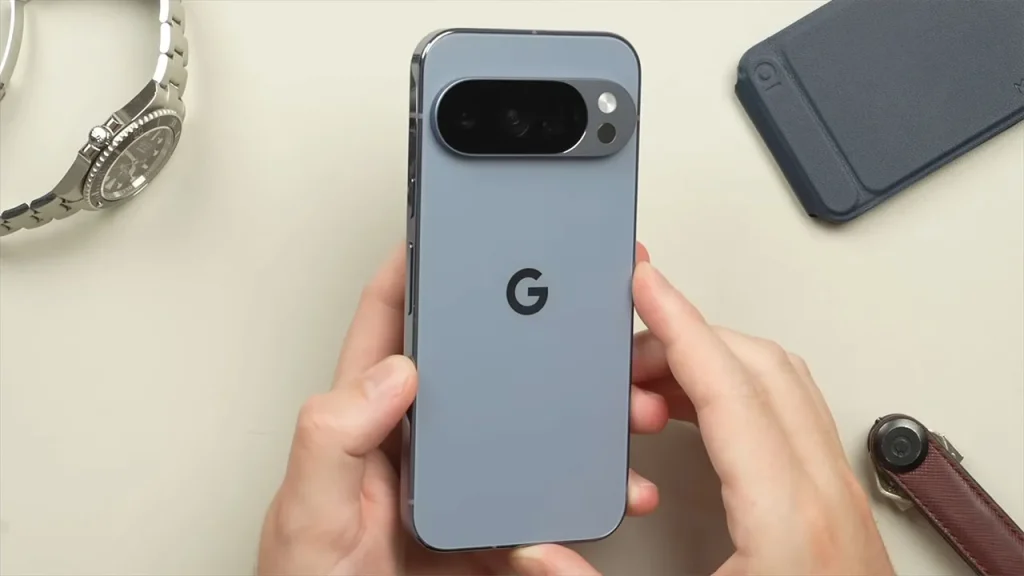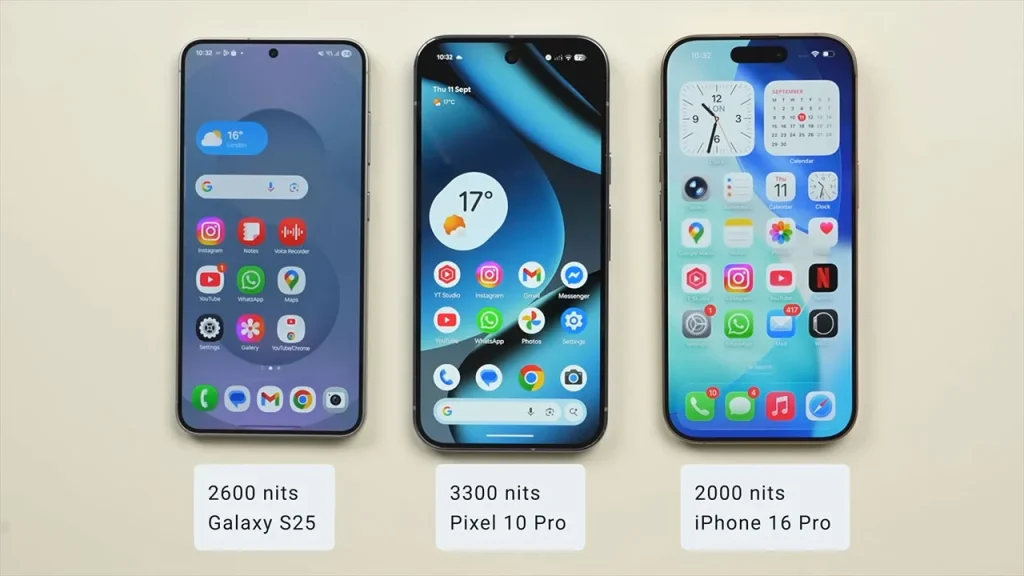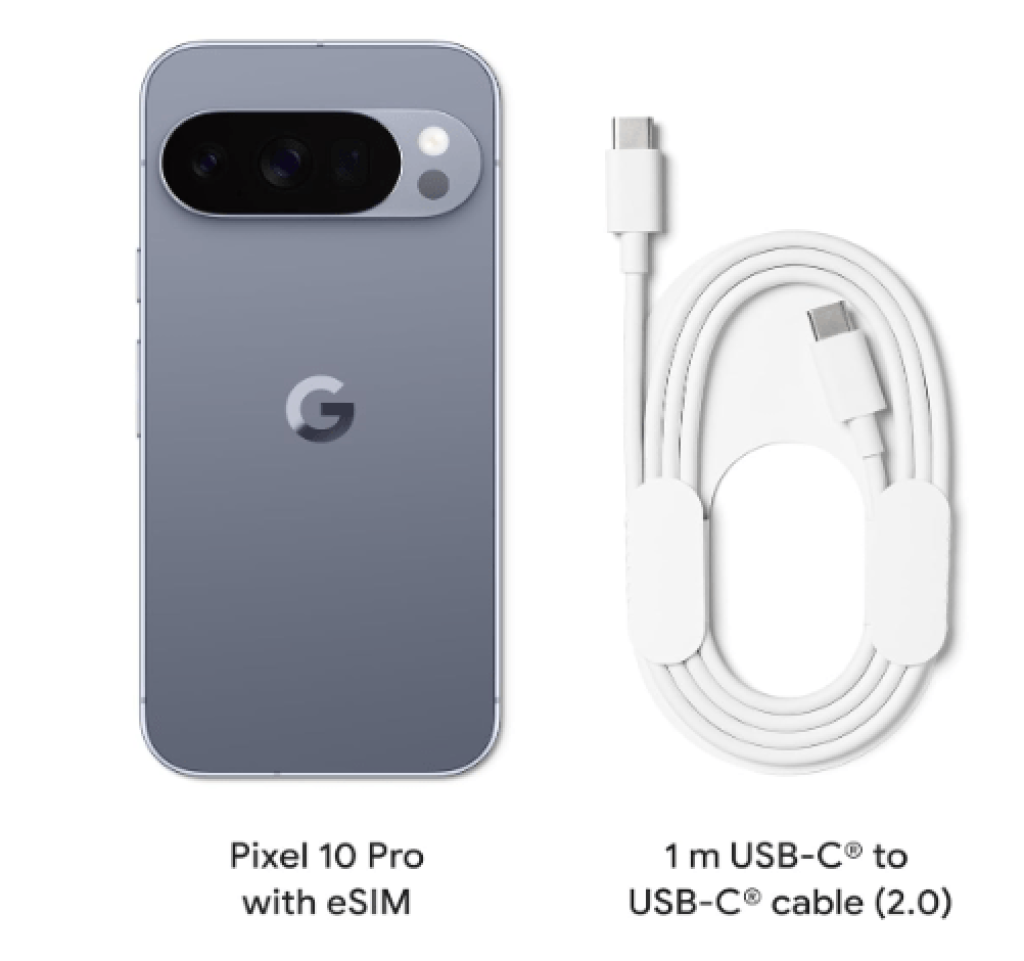
Google has unveiled a new phone called the Pixel 10 Pro and says that with this phone, it has brought the future into your hands! It says that this is not just a piece of hardware, it is a real intelligent assistant that lives with you. Google has always had a philosophy that software is king and hardware should serve it; and the Pixel 10 Pro is exactly the pinnacle of this thinking. On paper, everything looks great; the best artificial intelligence, a camera that takes magical photos and a pure and smooth Android experience.
But the main and vital question for us is; how real are all these claims and glamour in the strange market? Is this phone a cool and revolutionary update to the previous generation or is it the Pixel 9 Pro in a new dress? In our review of the Google Pixel 10 Pro, we are going to take a close look at everything about this phone.
Let’s move on to the design, where Google has decided not to touch its successful formula. The Pixel 10 Pro follows the same design language as previous generations with the famous horizontal camera bar. When you hold the phone in your hand, it feels like a luxury and premium product. The body is a combination of high-quality matte glass on the back and a shiny and polished aluminum frame that gives it a special beauty. This combination is not only beautiful, but also makes it less likely to leave fingerprints.
If you’ve seen the Pixel 9 Pro, the design of the Pixel 10 Pro will be very familiar to you, because the changes are really minor. The dimensions of the phone are almost unchanged at 152.8 x 72.0 x 8.5 mm, just a little thicker and weighing 207 grams, a little heavier than the previous generation, which you may feel in your hand. This means that Google has reached a maturity in design and does not intend to take any big risks right now. So if you’re looking for a completely new and revolutionary design, this is not the case here.
In terms of build quality, Google has left no stone unturned. Both the display and the back of the phone are made of Gorilla Glass Victus 2, which is one of the most durable glass available and gives you peace of mind about possible scratches and bumps. IP68 certification is also in place as always, so this phone is waterproof and can last up to 1.5 meters for 30 minutes. Google has also added some new and attractive colors like Moonstone and Jade to the previous colors this year to give you more options. One special thing about the Pixel design is the placement of the buttons; the power button is located above the volume buttons, which may be a bit strange at first, but you can get used to it in the long run. Overall, the Pixel 10 Pro’s design may not be exciting, but it is undoubtedly high-quality, stylish and practical. Google Pixel 10 Pro XL Review

Google Pixel 10 Pro Display Review
Now, let’s get to one of the best parts of this phone, namely its display. Google has put a 6.3-inch LTPO OLED panel here, which it calls the Super Actua Display. The resolution of this display is 1280 x 2856 pixels and the pixel density is about 495 pixels per inch. What do these numbers mean in simple terms? It means that everything, from text to photos and videos, is displayed in incredibly high detail and in a stunningly sharp and clear way.
But the real trump card of this display is its incredibly high brightness. The maximum brightness of this panel reaches an amazing 3300 nits. This means that even if you are in direct sunlight in the middle of the summer afternoon, you can comfortably and without any problems use the phone and see the content on the screen clearly. This is a noticeable improvement over the 3000 nit brightness of the Pixel 9 Pro and puts the Pixel 10 Pro above some competitors like the Galaxy S25 Ultra in this area. Of course, the difference between 3000 and 3300 nits may be hard to tell with the naked eye, but knowing that your display is one of the brightest on the market is a good feeling.
LTPO technology also allows this display to intelligently change the refresh rate between 1 and 120 Hz. When you’re scrolling through Instagram or playing games, the refresh rate is set to 120 Hz so that everything is crystal clear. But when you’re looking at a still photo or reading a book, the refresh rate drops to 1 Hz to minimize battery consumption. This feature not only makes the user experience more enjoyable, but also helps greatly with battery life. Full support for HDR10+ content and 24-bit color depth also make colors vivid, accurate, and pleasing to the eye when watching movies and series on platforms like Netflix. In short, the Pixel 10 Pro’s display is one of the best you can find on a smartphone.
Google Pixel 10 Pro Battery Review
| Topic | Features / Details | Key Points |
|---|---|---|
| Battery | 4,870 mAh | Small improvement; lasts over 24 hours with normal use. |
| Chip & Display | Tensor G5 chip & LTPO display | Power-efficient for all-day heavy use. |
| Fast Charging | 30W Wired | Charges to 55% in 30 mins; decent but slower than competitors. |
| Wireless Charging | Pixelsnap (Qi2 standard) | 15W magnetic charging; similar to MagSafe; uses universal standard. |
| In the Box | No Charger | Only a USB-C cable is included. |
One of our constant concerns when buying a phone is the battery. Google has included a 4,870mAh battery for the Pixel 10 Pro, which is a small but positive improvement over the previous generation. Google itself claims that this battery will last for more than 24 hours of normal use. Given the optimizations made to the Tensor G5 chip as well as the LTPO display that manages power consumption, we can expect the Pixel 10 Pro to easily handle a full day of heavy use and still have some charge at the end of the night.
Google Pixel 10 Review
When the phone is finished charging, it’s time to charge it quickly. The Pixel 10 Pro supports 30W wired fast charging, which can fill the battery to 55% capacity in about 30 minutes. This speed is quite suitable for everyday use, but if we compare it with Chinese flagships that have charging speeds of 100W and higher, it doesn’t have much to say.
But the good news this year is the addition of a very useful feature called Pixelsnap. This feature is exactly like Apple’s MagSafe and uses the Qi2 global standard. That is, there are a series of magnets on the back of the phone that magnetic wireless chargers stick to and charge the phone at a speed of 15 watts. This is a big step for Google, because not only does it make wireless charging easier and more accurate, but because it uses a global standard, you don’t have to buy expensive Google accessories and you can use a variety of products from other companies.
And finally, the negative point that has almost become a standard in the world of flagships; there is no charger in the box, only a USB-C to USB-C cable. So you have to add the cost of buying a proper 30-watt charger to the price of the phone.
Google Pixel 10 Pro Camera Review
| Aspect | Key Details | Performance & Features |
|---|---|---|
| Hardware | Same sensors as predecessor (50MP main, 48MP ultra-wide, 48MP periscope telephoto). | Relies on new Tensor G5 chip and advanced AI for improvements, not new hardware. |
| Daylight Photos | Excellent detail, natural colors, great dynamic range. | Software features like “Best Take” and “Real Tone” are improved. |
| Zoom | 5x optical zoom from periscope lens. | AI-powered “Pro Res Zoom” up to 100x; quality rivals top competitors. |
| Night & Selfie | Night Sight for bright, low-noise dark shots. 42MP ultra-wide selfie camera. | Effective in dark environments; high detail for single and group selfies. |
| Video Recording | New 8K recording. Video Boost uses cloud processing. | Improves quality, color, and stability. Lacks 4K 60fps HDR; lags behind iPhone in pro video. |
The camera has always been the main strength of the Pixel phones, and it’s where Google does wonders with its software image processing. At first glance at the hardware specifications, you might be a little disappointed. The main camera sensors (50-megapixel wide), ultra-wide (48-megapixel), and periscope telephoto (48-megapixel) are pretty much the same as those on the Pixel 9 Pro. This means that instead of changing the hardware, Google has decided to improve the quality of the photos with the power of the new processor and more advanced AI algorithms.
In daytime photography, the result is as always excellent. Google’s image processing is impeccable, and the photos have incredible detail, accurate and natural colors, and excellent dynamic range. The photos are neither oversaturated nor lifeless; they capture exactly what your eyes see. Software features like Best Take (which picks the best face for each person from a series of photos) and Real Tone (which captures skin tones as naturally as possible) are still there and have gotten better.
But where the Pixel 10 Pro really shines is in the zoom department. The phone’s periscope telephoto lens gives you a high-quality 5x optical zoom. But the real magic is the Pro Res Zoom feature, which uses AI to enable digital zoom up to 100x. The zoom quality at long distances is noticeably better than the previous generation, and now it can compete shoulder to shoulder with giants like the Galaxy S25 Ultra, and in some cases even capture better detail.
In night photography, the Night Sight feature performs as always. Even in the darkest environments, the Pixel can take bright photos with very little noise and acceptable detail. The 42-megapixel ultrawide selfie camera is great for both single selfies and group shots, capturing plenty of detail. In the video department, Google has finally added 8K video recording to its flagship. The Video Boost feature also uses cloud processing to dramatically improve the quality, color, and stability of videos, giving you a more cinematic output. However, the Pixel still has limitations in some areas of video recording, such as recording HDR video in 4K and 60 frames per second, and perhaps in this area, the iPhone 17 Pro is still a more professional choice.
Pixel 10 Pro Hardware Review
The beating heart of this phone is Google’s new generation of proprietary chips, the Tensor G5, built on a 3nm architecture. Here’s a very important thing to know: Google’s strategy for building chips is different from Apple and Qualcomm. Google has put all its effort into improving artificial intelligence (AI) and machine learning (ML) performance, not necessarily breaking benchmark records and raw processing power. What’s the result of this strategy? In everyday tasks, browsing the web, switching between apps, and using the phone’s smart features, the Pixel 10 Pro runs like a rocket, thanks to 16GB of RAM and fast UFS 4.0 storage, giving you an incredibly smooth and lag-free experience.
But this strategy also has an Achilles heel: gaming! This is exactly where the Tensor G5 falls behind powerful competitors like the Snapdragon 8 Elite in the Galaxy S25 Ultra and the A19 Pro chip in the iPhone 17 Pro. If you’re a serious gamer looking to play heavy games like Genshin Impact at the highest graphics settings and a steady frame rate, the Pixel 10 Pro might disappoint you. In heavy graphics tests, it underperforms its rivals and may even experience overheating issues. So remember, the Pixel 10 Pro is a smartphone, not necessarily a powerful gaming phone.
Google Pixel 10 Pro Software Review
Now, we’ve come to the part that sets the Pixel apart from other Android phones; software and AI. This is the soul and main identity of this phone. The first and most important feature is the Android 16 experience in its purest form. There are no unnecessary apps installed on the phone, there is no heavy user interface, and everything is exactly as Google designed it; simple, beautiful, and incredibly smooth.
Google’s second big trump card is its 7-year software support promise. This means you’ll get the latest versions of Android and security updates for 7 years. This means your phone will stay up to date and secure for years to come, which is a huge advantage that will help it retain its value in the long run.
But the real story this year is Gemini’s deep integration of AI into every part of the operating system. Google has introduced a series of magical features that will transform the experience of using your phone:
- Magic Cue: This is an intelligent assistant that is always aware of the content on the screen and automatically shows you relevant suggestions and information. For example, if you’re chatting about a restaurant, it will bring you the address and menu.
- Camera Coach: If you’re not a professional photographer, this feature is like a coach by your side. AI will help you find the best frame, light, and angle for your shot.
- Edit with Ask Photos: Editing photos couldn’t be easier. Just tell Google Photos what you want in conversational language. For example, say; Make this person smile more or remove this extra object from the background.
- Circle to Search: This feature has been around for a while, but it’s now even better. Draw a circle around anything you see on the screen, from a shoe to a monument, and Google will instantly find information about it.
These are just a few examples of Google’s wizardry. Many of these cool AI features that Google is so good at maneuvering around rely on the internet to work and are only available in certain regions and languages.
Google Pixel 10 Pro Speaker Review
In terms of sound, the Pixel 10 Pro does it simply but right. The phone is equipped with stereo speakers, one on the bottom edge and the other on the top edge of the display (which also acts as the speaker for calls). The sound quality is very good; it’s loud enough, with acceptable separation, and is perfectly satisfactory for watching movies, playing games, and listening to music.
Like almost all flagships these days, there’s no 3.5mm headphone jack. So, if you want to listen to music, you’ll need to consider buying a pair of quality wireless headphones or using a USB-C to 3.5mm adapter. Overall, the Pixel 10 Pro’s speakers aren’t a great strength, but they do the job well and don’t have any major weaknesses.
Is the Google Pixel 10 Pro worth buying?
So, we’ve come to the bottom line and the most important part of the Google Pixel 10 Pro review; with all these pros and cons, is the Google Pixel 10 Pro worth buying in the market? Let’s first have a quick summary of its pros and cons.
Pixel 10 Pro’s strengths:
- Unparalleled software experience: Pure, smooth Android with 7 years of software support.
- Super smart camera: The best image processing in the mobile world that captures amazing photos.
- Stunning display: One of the brightest and highest quality displays on the market.
- Excellent build quality: Feels like a luxury and premium product with IP68 waterproof standard.
Pixel 10 Pro’s weaknesses: - Average processing performance: Weaker than its main competitors in gaming and graphic-intensive tasks.
- Low hardware improvement: Compared to the Pixel 9 Pro, the hardware changes are not very impressive.
- Normal charging speed: The 30W charging speed is nothing compared to Chinese competitors.
Now let’s get to the point; is the Pixel 10 Pro worth buying or not?
The Google Pixel 10 Pro is a fantastic phone; a masterpiece of software engineering that shows that the future of mobile phones lies in artificial intelligence. If you are crazy about pure Android and smart cameras, do not hesitate to buy it.
But here, the story is completely different. With this space price, with these registry and import problems, with the lack of 5G support and with the risk of its main features not working, buying the Pixel 10 Pro is like walking on a razor’s edge. This phone is only for a very special group; those who love Pixel, are not afraid to take risks, have very high technical knowledge and are willing to sacrifice a valid warranty, peace of mind, 5G and a lot of extra money for a special software experience. For the rest of us, there are much, much smarter, less cumbersome, and more powerful options on the market, like Samsung or even Apple flagships, that offer the same features and more at a more reasonable price and without any of these risks. So in short; the Pixel 10 Pro is a great phone.





